
The parsnip is a root vegetable closely related to carrot and parsley, all belonging to the flowering plant family Apiaceae. It is a biennial plant usually grown as an annual. Its long taproot has cream-colored skin and flesh, and, left in the ground to mature, it becomes sweeter in flavor after winter frosts. In its first growing season, the plant has a rosette of pinnate, mid-green leaves. If unharvested, in its second growing season it produces a flowering stem topped by an umbel of small yellow flowers, later producing pale brown, flat, winged seeds. By this time, the stem has become woody and the tap root inedible.

Heracleum maximum, commonly known as cow parsnip, is the only member of the genus Heracleum native to North America. It is also known as American cow-parsnip, Satan celery, Indian celery, Indian rhubarb or pushki.

Cicuta maculata is a highly poisonous species of flowering plant in the carrot family known by several common names, including spotted water hemlock, spotted parsley, spotted cowbane, and the suicide root by the Iroquois. It is native to nearly all of North America, from northern Canada to southern Mexico.
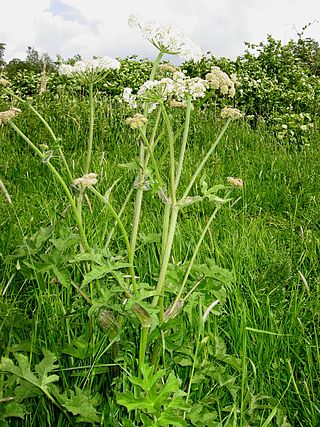
Heracleum sphondylium, commonly known as hogweed, common hogweed or cow parsnip, is a herbaceous perennial or biennial plant, in the umbelliferous family Apiaceae that includes fennel, cow parsley, ground elder and giant hogweed. It is native to Europe and Asia. The common name eltrot may also be applied, but is not specific to this species. Umbelliferous plants are so named because of the umbrella-like arrangement of flowers they produce. The North American species Heracleum maximum is sometimes included as a subspecies of H. sphondylium.
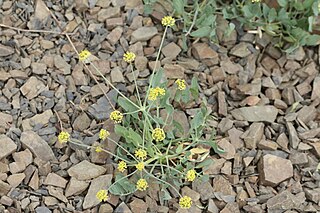
Lomatium nudicaule is a species of flowering plant in the carrot family known by the common names pestle lomatium, barestem biscuitroot, Indian celery and Indian consumption plant. It is native to western North America from British Columbia to California to Utah, where it is known from several habitat types, including forest and woodland. It is a perennial herb growing up to about 70 centimetres (28 in) tall from a thick taproot. It generally lacks a stem, the inflorescence and leaves emerging from ground level. The leaves are made up of many dull green, waxy lance-shaped leaflets each up to 9 cm long. The inflorescence is borne on a stout, leafless peduncle widening at the top where it blooms in an umbel of yellow or purplish flowers.

Lomatium utriculatum is a species of flowering plant in the carrot family known by the common name common lomatium or spring gold. It is native to western North America from British Columbia to California, where it grows in many types of habitat including chaparral, and in the Sierra Nevada.
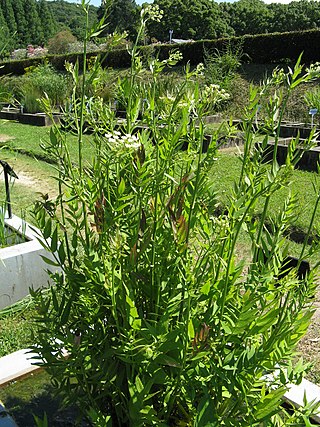
Sium suave, the water parsnip or hemlock waterparsnip, is a perennial wildflower in the family Apiaceae. It is native to many areas of both Asia and North America. The common name water parsnip is due to its similarity to parsnip and its wetland habitat. The alternate common name hemlock waterparsnip is due to its similarity to the highly poisonous spotted water hemlock.
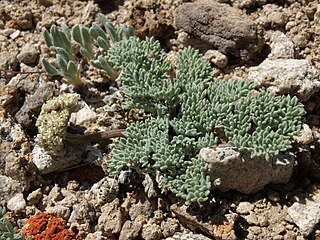
Cymopterus cinerarius is a species of flowering plant in the carrot family known by the common name gray springparsley. This small plant is native to the US states of California and Nevada, where it grows on the rocky talus of the Sierra Nevada. This plant has a short stem and lies against the ground or draped over rocky debris. Its distinctive leaves are only a few centimeters long and dissected into segments of a few millimeters in length. The gray-green segments are thick, pointed lobes with a bumpy textured surface and a waxy epidermal coating. From the center of this patch of leaflets sprouts an erect peduncle holding the flowers. The peduncle and the umbels of flowers are reddish-green or brown and the umbel has very large wrinkly bracts which are more visible than the actual white flower corolla.
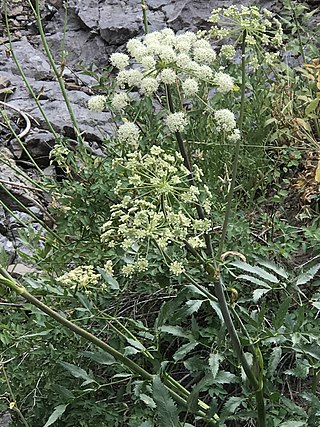
Angelica breweri is a species of angelica known as Brewer's angelica. It is native to the high mountain ranges of eastern California and far western Nevada, where it grows in coniferous forests. This is a taprooted perennial herb producing an erect, hollow, hairy stem to heights between 1 and 2 meters. The large leaves are composed of many highly dissected leaflets, each up to 10 centimeters long. The inflorescence is a compound umbel with up to 50 long rays holding clusters of hairy white flowers. The base of each pedicel has a thick webbing. The fruit is a pair of ribbed bodies, each containing a seed.
Angelica callii is an uncommon species of angelica known as Call's angelica. It is endemic to the Sierra Nevada of California, where it grows by forest streams.

Angelica hendersonii is a species of angelica known as Henderson's angelica. It is native to the west coast of the United States from Washington to central California, where it grows in the coastal sage scrub and other habitat on the immediate coastline. This is a taprooted perennial herb producing a branching erect stem to heights between about 1 and 2 meters. The basal leaves are made up of oval-shaped leaflets each up to 10 centimeters long, with toothed edges and white woolly undersides. The woolly inflorescences are compound umbels of up to 60 rays holding clusters of fuzzy flowers. The flowers yield fruits which are paired bodies nearly a centimeter long each containing a seed.

Angelica lineariloba is a species of Angelica known as poison angelica or Sierra angelica. It is native to the Sierra Nevada and nearby slopes and flats in California and western Nevada from 6000 to 10,600 ft in elevation. This is a taprooted perennial herb producing an erect, hollow stem up to about 1.5 meters tall. The large but feathery leaves are made up of many highly dissected leaflets which are linear to threadlike in shape. The inflorescence is a compound umbel with up to 40 rays holding clusters of small white to cream flowers. There are papery sheaths at the base of each petiole where it branches from the stem. The plants overall are rather similar to the other large umbellifers cow parsnip and swamp whiteheads, but cow parsnips have huge lobed but undivided leaves, while swamp whiteheads have pinnate leaves and the individual flowerheads are dense, round balls.

Lomatium caruifolium, known by the common name alkali desertparsley, is a species of flowering plant in the carrot family.
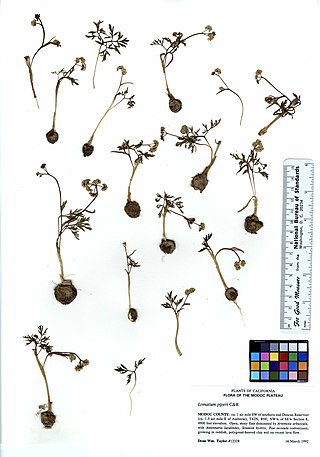
Lomatium piperi is a species of flowering plant in the carrot family known by the common name salt-and-pepper or Indian biscuitroot. It is native to the Northwestern United States and northern California, where it grows in sagebrush and plateau habitat, and the Sierra Nevada and Cascade Mountains.

Perideridia kelloggii is a species of flowering plant in the family Apiaceae known by the common name Kellogg's yampah. It is endemic to California, where it is known from the north and central coasts, the San Francisco Bay Area, and the Sierra Nevada foothills. It grows in grassland habitat, sometimes on serpentine soils. It is a perennial herb which may reach 1.5 meters in maximum height, its slender, erect stem growing from a cluster of long, narrow, fibrous roots each up to 15 centimeters long. Leaves near the base of the plant have blades up to 45 centimeters wide which are divided into many leaflets subdivided into narrow, elongated lobes. The inflorescence is a compound umbel of many spherical clusters of small white flowers. These yield ribbed, oblong-shaped fruits each about half a centimeter long.

Perideridia oregana is a species of flowering plant in the family Apiaceae known by the common names Oregon yampah and eppaw. It is native to Oregon and California in the western United States, where it grows in woodland and other habitat. This plant is quite variable in appearance. In general, it is a perennial herb 10 to 90 centimeters tall, its green to waxy-grayish erect stem growing from a cluster of small tubers. Leaves near the base of the plant have blades 3 to 30 centimeters long divided into a variable number of leaflets, which may be subdivided into smaller segments. The inflorescence is a compound umbel of many spherical clusters of small white flowers. These yield ribbed, oblong-shaped fruits 3 to 6 millimeters long.
Tauschia parishii is a species of flowering plant in the carrot family known by the common name Parish's umbrellawort. It is endemic to California.

Torilis arvensis is a species of flowering plant in the family Apiaceae known by the common names spreading hedgeparsley, tall sock-destroyer and common hedge parsley. It is native to parts of Europe and it is known elsewhere, such as North America, as an introduced species and a common weed. It grows in many types of habitat, especially disturbed areas. It is an annual herb producing a slender, branching, rough-haired stem up to a meter in maximum height. The alternately arranged leaves are each divided into several pairs of lance-shaped leaflets up to 6 centimeters long each. The leaflet is divided or deeply cut into segments or teeth. The inflorescence is a wide open compound umbel of flower clusters on long, slender rays. Each flower has five petals which are unequal in size and are white with a pinkish or reddish tinge. Each greenish or pinkish fruit is 3 to 5 millimeters long and is coated in straight or curving prickles.

Cicuta bulbifera, commonly known as the bulb-bearing water-hemlock, is a plant native to North America and one of four species in the poisonous genus Cicuta. Tiny bulbils form in the leaf joints in the upper part of the plant, giving the plant its scientific and common names. Cicuta bulbifera can be distinguished from Cicuta douglasii by its narrow leaflet segments and its bulbil-bearing upper leaf axils.

Thaspium trifoliatum, commonly called meadow-parsnip or purple meadow-parsnip is a species of flowering plant in the carrot family (Apiaceae). It is native to eastern North America where it is found in many eastern U.S states and in Ontario, Canada. It has a broad natural habitat, which includes mesic to dry forests and woodlands, prairies, bluffs, and rock outcrops.



















